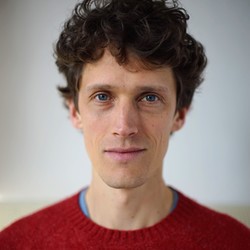
Dr Jarvist Moore Frost
Electronic Mail: Jarvist.Frost@imperial.ac.uk
Postal Address:
Dr Jarvist Moore Frost
Department of Physics
King’s College London
Strand
London, WC2R 2LS - UK
Research statement
Over 122 Petawatts of solar power reach the Earth’s surface. This figure is vastly greater than humanity’s total power requirement (15 Terawatts).
Long term (in a century or two) I think it is inevitable that all of our power will be solar power. 76 GWp of solar power was installed during 2016, the growth is currently exponential. All the energy in fossil fuels is essentially ancient sunlight, captured by inefficient photosynthesis and geological happenstance.
Solar cells (formally called photovoltaics, as they generate electrical voltage from photons of light) are a beautifully simple engine that silently run on sunlight and thermodynamics to produce electrical power. There are no parts to wear out, no bearings to service, no oil to change. The only problem is that the solar resource is not very concentrated — bright sunlight provides about a kilowatt of power per metre squared. So you have to build big panels (and cover a not insignificant land area) to produce a meaningful amount of energy.
Our present best technology for making photovoltaics is based on Silicon. This is an abundant material (sand is mainly silicon dioxide), but forming pure Silicon requires a lot of energy, and making silicon solar panels requires vacuum processing and some pretty nasty chemicals which keeps the cost relatively high.
My research is in trying to understand and design new materials for solar cells. We try to understand how experimental solar cells work (in particular, what limits their efficiency or longevity), and how we can make them better. These new solar cells are typically more complex than silicon cells – rely on the subtle interplay of multiple elements in a complex structure or fiendishly complex molecules dreamt up by an organic chemist (and then we often don’t even know the structure!).
I work with computational physics techniques. Everything we see and touch and hear is due to the electronic structure of the materials around us. The equations which govern this quantum mechanical behaviour are simple to write down, but impossible to solve exactly for any but the most trivial of examples. Instead we rely on computational algorithms to numerically solve approximate models for the real system.
Even very limited and flawed solutions of small systems can require absolutely stunning amounts of computer time. The systems I woke on are often disordered, and dynamically responding, requiring new methods to be developed, and toy models to be devised. Validating (against reality) these models and understanding the limits of the techniques available, is what I spend the majority of my time doing.
Previously I was a PostDoc on the EPSRC Programme Grant Energy Materials: Computational Solutions, working in the Walsh Material Design group (Department of Chemistry, University of Bath; then Department of Materials, Imperial College London).
So far the majority of my computer time has been provided by EPSRC on the new Cray XC30 supercomputer ARCHER.
This blog & other online presence
This is my academic (mainly!) blog. It used to be on Wordpress, at
https://jarvistmoorefrost.wordpress.com.
Files were extracted to a plain text Markdown format, and are now published
with Hugo with the nofancy theme (slightly
tweaked).
I moved this blog from Wordpress to GitHub pages as I had grown irritated with
the online-only editing experience (in particular their new ‘Web 2.0’
experience made my laptop overheat!).
I hope that being able to edit and push from the command line will get me
blogging more regularly.
In January 2016 I started using a Google+ ‘Collection’ to publish reviews of Electronic Structure Theory books.
You may find my academic papers on Google Scholar, or via my ORCID ID.
On Twitter I’m @JarvistFrost. Find my Molecular Dynamics videos on YouTube I try and put my conference and tutorial slides on SpeakerDeck, as and when I’ve had time to redact any unpublished experimental data of collaborators.
Outside academics, I have less and less time for riding bicycles, sailing, diving and exploratory caving. But the little I have written up, is accessible at https://jarvbites.wordpress.com/.
